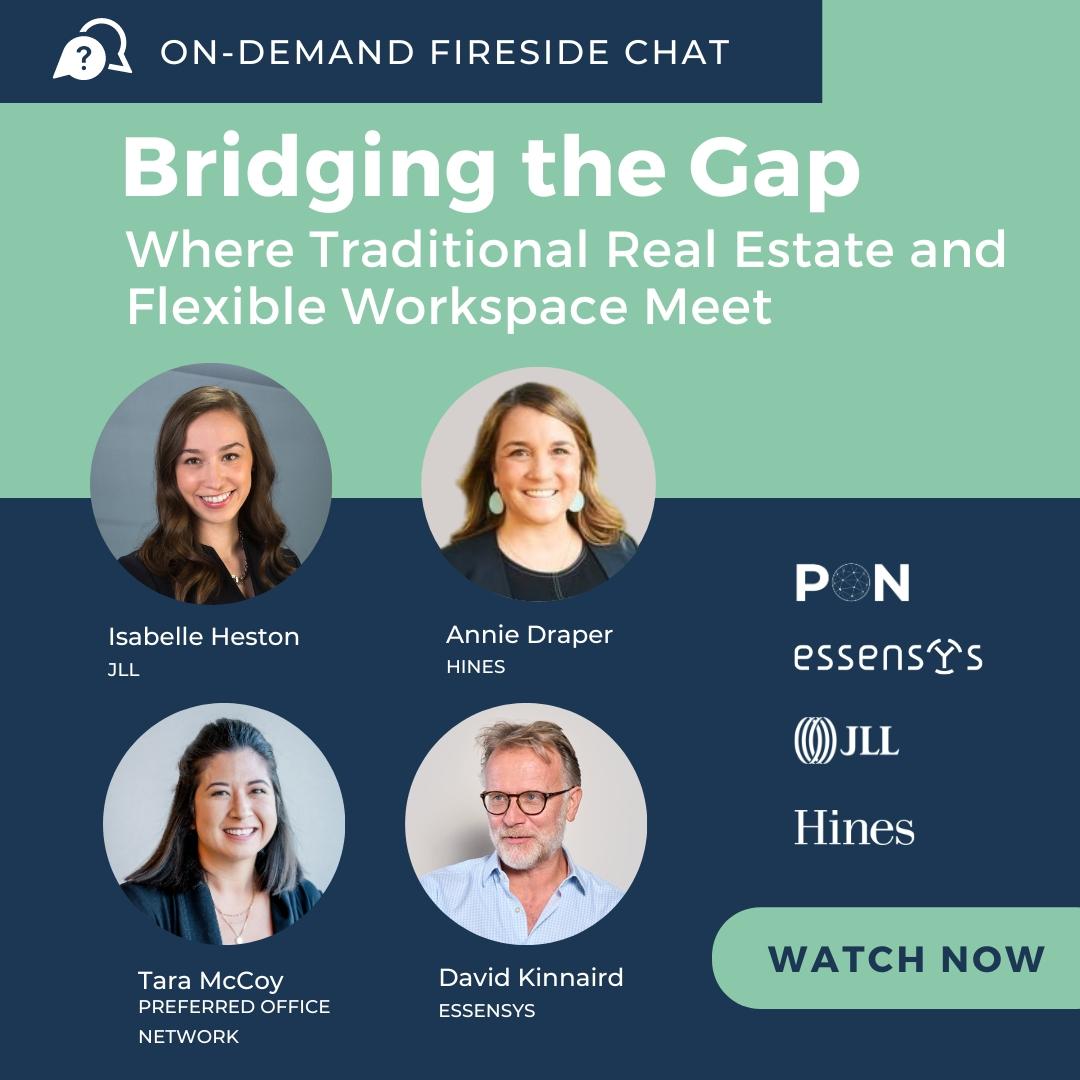
Bridging the Gap: Where Traditional Real Estate and Flexible Workspace Meet – Webinar Recap
Top takeaways from our recent fireside chat featuring real estate industry trailblazers discussing strategies and solutions that can revolutionize the modern workplace
Preferred Office Network recently gathered real estate industry experts to explore the evolving field of commercial real estate, where navigating the new world of work has required monumental shifts and a rethinking of portfolio management.
Our own VP of Strategy, Michele Penaranda, Enterprise Accounts Senior Manager Tara McCoy, and Head of Global Partnerships Caroline Hecht sat down with Isabelle Heston, Senior Vice President at JLL; Annie Draper, flex office expert, real estate strategist, and Director at Hines; and David Kinnaird, Chief Customer Officer at essensys. This all-star lineup traversed this new terrain, delving into innovative strategies and solutions for today’s modern workplaces.
Here are our top five takeaways from their insightful, informative, and inspiring conversation. To watch the full webinar, “Bridging the Gap: Where Traditional Real Estate and Flexible Workspace Meet,” click here.
- Data is largely driving the push towards coworking. JLL’s Heston shared a hot take on coworking’s rise in prominence: the powerful ability to track occupancy data via access to new technologies that guide impactful real estate decisions. “Our client has close to 400 locations, and [pre-pandemic], they were only using coworking for a sliver of their portfolio… What we’ve seen since the pandemic is that they’re leaning heavily into coworking solutions, and I think one of the biggest drivers of that has been the push for companies to look at BI and the data that they can track. We’re seeing companies looking at occupancy data, badge swipes, and other types of technologies and trying to make better informed decisions about their portfolio with that information.”
- Different ways of working require a variety of choices in today’s workspaces. The panel acknowledged our way of working looks nothing like it did back in 2019. Hines’ Draper recalled her company offering a fairly standard office product with a traditional long-term leasing structure. That model no longer works in today’s world of work. “Now that every company is operating in these different ways and there are different requirements from every company even within how different departments are functioning and people within those departments all need different things from office space these days,” she said. “It makes it more difficult for traditional landlords to stand by the standard fixed conventional leasing structure.”
- Coworking = connectivity. Flexible workplaces offer the human connection and spirit of collaboration that individuals working from home were missing out on, but, at the risk of sounding too literal, coworking operators can provide the infrastructure, technology, and flexibility that allows companies to advance and succeed with an increasingly globalized and ever-evolving workforce. As essensys’ Kinnaird said, “The trick is where the [coworking] operator can bring something to the landlord that they couldn’t do before.” This means delivering digitally enabled and highly adaptable spaces that accommodate how people work today and how organizations can future proof their portfolios.
- Flexible workspaces offer efficiencies and savings that go beyond the cost of a long-term lease. We are living in a world where costs are going up across all aspects of modern life. Heston shared some eye-opening numbers related to the hard reality of construction costs, supply chain issues, and building timelines that make it near impossible to schedule an office delivery on time. These factors can negatively affect a company’s ability to build new office space from the ground up — and hinder the organization’s progress in the process. Flexible workspaces provide a ready-made solution. “Having a coworking facility that we can have up and running in the matter of days or weeks is appealing to [our client]. It really is a go-to solution.” She expanded on the cost effectiveness of flex, as well: “We are seeing companies really trying to rein in their capital spend. They are being much more effective and cautious in their spending, so when you have coworking that essentially has everything ready to go, they don’t have to worry about getting into these long-term commitments. And, most importantly, they do not have to employ those services like Facilities Management.”
- Coworking operators aren’t just tenants — they’re the heart of a building. Kinnaird explained the complexities — and the inherent value — of operating a coworking space within an office building. From delivering a full stack of services and amenities and creating an environment of hospitality (that often extends throughout the entire building) to accommodating a wide range of clients seamlessly, coworking spaces are “where the magic is happening,” he said.
Preferred Office Network’s Penaranda shared details of our exciting new offering: Preferred Suites, a creative new solution that leverages our exclusive coworking network to extend its flexible occupancy model in a product that delivers wins for landlords and tenants alike. “There’s a new demand of a flex space product offering but a larger space requirement, and how do you solve for that? Preferred Suites is bridging that gap … and creating an extension of the coworking operator. It leans more into what we’re trying to achieve — we look at coworking operators as the heart of a building, and there’s so much potential there.”
